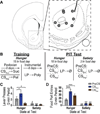Nucleus accumbens core dopamine signaling tracks the need-based motivational value of food-paired cues
- PMID: 26715366
- PMCID: PMC4819964
- DOI: 10.1111/jnc.13494
Nucleus accumbens core dopamine signaling tracks the need-based motivational value of food-paired cues
Abstract
Environmental reward-predictive stimuli provide a major source of motivation for instrumental reward-seeking activity and this has been linked to dopamine signaling in the nucleus accumbens (NAc) core. This cue-induced incentive motivation can be quite general, not restricted to instrumental actions that earn the same unique reward, and is also typically regulated by one's current need state, such that cues only motivate actions when this is adaptive. But it remains unknown whether cue-evoked dopamine signaling is similarly regulated by need state. Here, we used fast-scan cyclic voltammetry to monitor dopamine concentration changes in the NAc core of rats during a Pavlovian-to-instrumental transfer task in which the motivating influence of two cues, each signaling a distinct food reward (sucrose or food pellets), over an action earning a third unique food reward (polycose) was assessed in a state of hunger and of satiety. Both cues elicited a robust NAc dopamine response when hungry. The magnitude of the sucrose cue-evoked dopamine response correlated with the Pavlovian-to-instrumental transfer effect that was selectively induced by this stimulus. Satiety attenuated these cue-evoked dopamine responses and behavioral responding, even though rats had never experienced the specific food rewards in this state. These data demonstrate that cue-evoked NAc core responses are sensitive to current need state, one critical variable that determines the current adaptive utility of cue-motivated behavior. Food-predictive stimuli motivate food-seeking behavior. Here, we show that food cues evoke a robust nucleus accumbens core dopamine response when hungry that correlates with the cue's ability to invigorate general food seeking. This response is attenuated when sated, demonstrating that food cue-evoked accumbens dopamine responses are sensitive to the need state information that determines the current adaptive utility of cue-motivated action.
Keywords: Pavlovian-to-instrumental transfer; hunger; mesolimbic dopamine; reward; satiety; voltammetry.
© 2015 International Society for Neurochemistry.
Conflict of interest statement
All authors report no financial interests or other potential conflicts of interest.
Figures


References
-
- Ackroff K, Manza L, Sclafani A. The rat's preference for sucrose, polycose and their mixtures. Appetite. 1993;21:69–80. - PubMed
-
- Balleine B. Asymmetrical interactions between thirst and hunger in Pavlovian-instrumental transfer. Q J Exp Psychol B. 1994;47:211–231. - PubMed
-
- Berridge KC. Reward Learning: reinforcement, incentives and expectations. In: Medin DL, editor. The Psychology of Learning and Motivation. Vol. 40. Academic Press; 2001. pp. 223–278.
Publication types
MeSH terms
Substances
Grants and funding
LinkOut - more resources
Full Text Sources
Other Literature Sources

